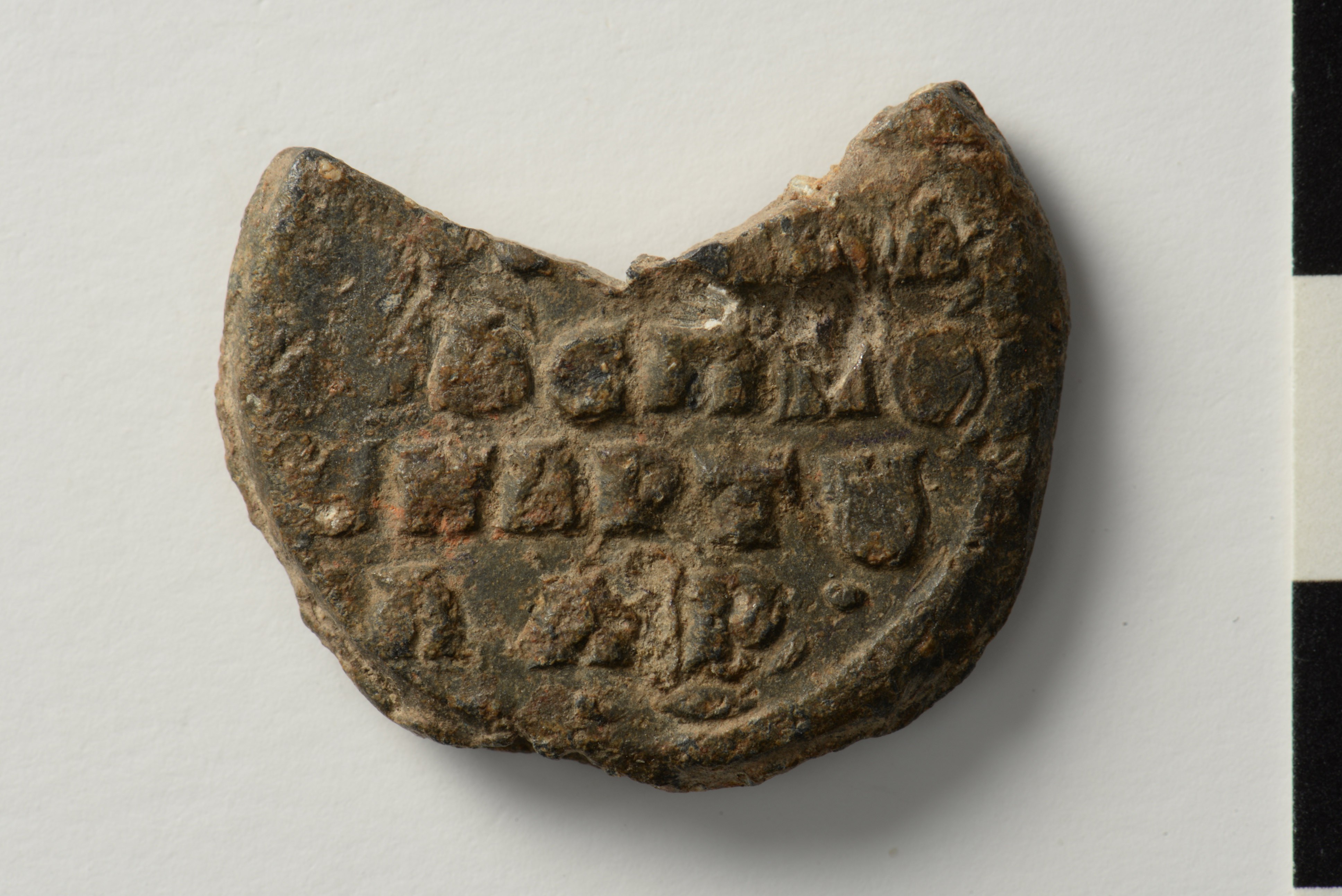Theodore imperial protospatharios, grand chartoularios of the genikon and anagrapheus of the Armenian themes (tenth/eleventh century)
Obverse
Inscription of at least four lines, a decoration below. Border of dots.
...εοδ,
ρ.,α̅σπαθ
χαρτ
λαρ,
- -
[Κ(ύρι)ε β(οή)θ(ει) Θ]εοδ(ώ)ρ(ῳ) [β(ασιλικῷ)] (πρωτο)σπαθ(αρίῳ), μ(ε)γ(άλῳ) χαρτουλαρ(ίῳ)
Obverse
Inscription of at least four lines, a decoration below. Border of dots.
...εοδ,
ρ.,α̅σπαθ
χαρτ
λαρ,
- -
[Κ(ύρι)ε β(οή)θ(ει) Θ]εοδ(ώ)ρ(ῳ) [β(ασιλικῷ)] (πρωτο)σπαθ(αρίῳ), μ(ε)γ(άλῳ) χαρτουλαρ(ίῳ)
Reverse
Inscription of five lines, a decoration below. Border of dots.
τ.
νικ..
ναγραφε.
τ,αρμεν,κ
θεματ,
- -
τ(οῦ) [γε]νικ(οῦ) [γε]νικ(οῦ) [(καὶ) ἀ]ναγραφε[ῖ] τ(ῶν) Ἀρμεν(ι)κ(ῶν) θεμάτ(ων)
| Accession number | BZS.1951.31.5.1152 |
|---|---|
| Diameter | 28.0 mm |
| Previous Editions | DO Seals 4, no. 56.1. See also Seibt, "Ἀρμενικὰ θέματα," 137, no. 19. |
| Credit Line | Harvard Art Museums/Arthur M. Sackler Museum, Bequest of Thomas Whittemore. |
Translation
Κύριε βοήθει Θεοδώρῳ βασιλικῷ πρωτοσπαθαρίῳ, μεγάλῳ χαρτουλαρίῳ τοῦ γενικοῦ γενικοῦ καὶ ἀναγραφεῖ τῶν Ἀρμενικῶν θεμάτων.
Lord, help Theodore, imperial protospatharios, grand chartoularios of the genikon and anagrapheus of the Armenian themes.
Bibliography
- Catalogue of Byzantine Seals at Dumbarton Oaks and in the Fogg Museum of Art, Vol. 4: The East (Open in Zotero)
- Die byzantinische Armee im 10. und 11. Jahrhundert: Studien zur Organisation der Tagmata (Open in Zotero)
- Les listes de préséance byzantines des IXe et Xe siècles (Open in Zotero)
- L’organisation de la frontière orientale de Byzance aux Xe-XIe siècles et Le Taktikon de l’Escorial (Open in Zotero)
- Byzantine Lead Seals, Vol. 2 (Open in Zotero)
- Ἀρμενικὰ Θέματα als terminus technicus der byzantinischen Verwaltungsgeschichte des 11. Jahrhunderts (Open in Zotero)
- The Land Legislation of the Macedonian Emperors (Open in Zotero)

Commentary
First attested in the middle of the tenth century, the “Armenian themes” drew their name from the Armenian groups which settled along the eastern frontier of the empire. They covered small territories, made up essentially of one fortress and its region, they provided mainly footsoldiers (less than a thousand each) and had a distinct administrative structure characterized by the large number of “tourmarchai” (the Charpezikion had 22 major toumarchai and 47 lesser ones). The Armenian themes (tentative list in Kühn, Armee, 61-64), scattered along the eastern frontier, were thus differentiated from the larger, traditional “Roman themes” lying to the interior. See Oikonomides, Listes, 345-46; Oikonomides, “Organisation;” and the recent and exhaustive study of W. Seibt, “Ἀρμενικὰ θέματα als terminus technicus der byzantinischen Verwaltungsgeschichte des 11. Jahrhunderts,” ByzSl 54 (1993) 134-41. Each Armenian theme had its own (low-grade) strategos (called zirwar by the Arabs, zoravar by the Armenians); not until the eleventh century do we meet a strategos of the Armenian themes in general (Zacos, Seals II, no. 844), indicating an effort to centralize the command of these scattered units. The numerous seals of the financial officials in our collection reflect the economic importance of the Armenian themes while those of the judicial officials bear witness to the effort necessary to maintain law and order in these frontier zones, especially among a population notorious for its lack of discipline (E. McGeer, The Land Legislation of the Macedonian Emperors [Toronto, 2000] 86-89).